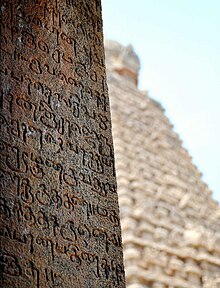Grantha script
The Grantha script (Grantha: 𑌗𑍍𑌰𑌨𑍍𑌥𑌲𑌿𑌪𑌿; Malayalam: ഗ്രന്ഥലിപി, romanized: granthalipi; Tamil: கிரந்த எழுத்து, romanized: Granta eḻuttu) is a classical South Indian Brahmic script, found particularly in Tamil Nadu and Kerala.[7][8] This early Grantha script was used to write Sanskrit texts, inscriptions on copper plates and stones of Hindu temples and monasteries.This stems from the practice of binding inscribed palm leaves using a length of thread held by knots.Grantha was widely used to write Sanskrit in the Tamil-speaking parts of South Asia from about the 5th century CE into modern times.[citation needed] In modern times, the Tamil-Grantha script is used in religious contexts by Tamil-speaking Hindus.[3] As in other Brahmic scripts Grantha consonant signs have an inherent vowel, typically corresponding to /a/, so, for example, the letter ⟨𑌕⟩ is pronounced /ka/.Each consonant in Grantha includes an inherent vowel a, so the letter ⟨𑌕⟩, for example, is pronounced ka.(Article 1 of the Universal Declaration of Human Rights) Grantha script was added to the Unicode Standard in June 2014 with the release of version 7.0.





AbugidaPallava GranthaSanskritEgyptianProto-SinaiticPhoenicianAramaicBrahmiTamil-BrahmiPallavaMalayalamTigalariThirkeSaurashtraDhives AkuruOld MonISO 15924UnicodeUnicode rangeBrahmic scriptsBrahmi scriptSharadaGurmukhiKhojkiKhudabadiMultaniMahajaniKamarupiSiddhamNagariDevanagariGujaratiNandinagariKaithiSylheti NagriBengali–AssameseBengaliAssameseTirhutaNepaleseBhujimolRanjanaSoyomboPracalitTibetanMeiteiLepchaPhagspaZanabazar squareMarchenTamyigKalingaBhaiksukiTocharianBhattiproluSinhalaKhom ThaiSukhothaiFakkhamThai NoiTai VietLai TayBalineseJavaneseOld SundaneseSundaneseLontaraMakasarUlu scriptsLampungRejangBaybayinHanunooTagbanwaKulitanMon–BurmeseBurmeseChakmaS'gaw KarenTanchangyaKhamtiTai LeModern MonTai ThamNew Tai LueVatteluttuKolezhuthuMalayanmaKadambaTelugu-KannadaKannadaGoykanadiTeluguromanizedSouth IndianBrahmic scriptTamil NaduKeralaPallava scriptMalayalam scriptSinhala scriptsManipravalamSouth AsiaTamil-Grantha scriptHindustraditional wedding cardsVelvikudi grant inscriptionMamallapuramTiruchirapalliMandagapattu Hindu templeBrahmicinherent vowelvirāmaligaturesdiacriticsSamavedaUniversal Declaration of Human RightsSinhaleseGrantha (Unicode block)GranthaGrantha and TamilArlo, Guywriting systemsHistory of writingGraphemeundeciphered